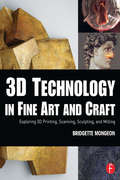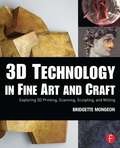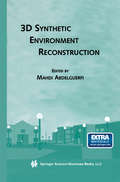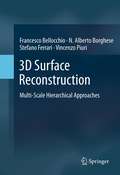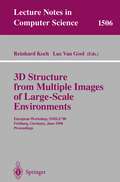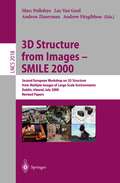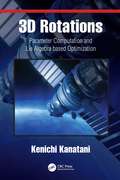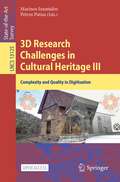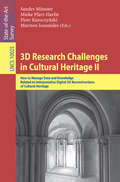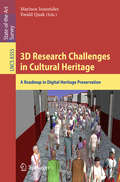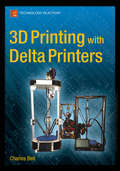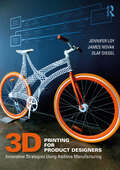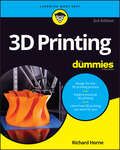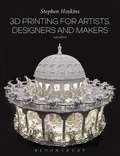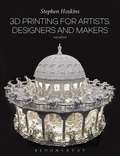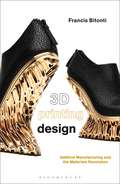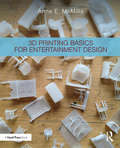- Table View
- List View
3D Technology In Fine Art And Craft (PDF)
by Bridgette MongeonThe possibilities for creation are endless with 3D printing, sculpting, scanning, and milling, and new opportunities are popping up faster than artists can keep up with them. 3D Technology in Fine Art and Craft takes the mystery out of these exciting new processes by demonstrating how to navigate their digital components and showing their real world applications. Artists will learn to incorporate these new technologies into their studio work and see their creations come to life in a physical form never before possible. Featuring a primer on 3D basics for beginners,interviews, tutorials, and artwork from over 80 artists, intellectual property rights information, and a comprehensive companion website, this book is your field guide to exploring the exhilarating new world of 3D. Follow step-by-step photos and tutorials outlining the techniques, methodologies, and finished products of master artists who have employed 3D technology in new and inventive ways Learn how to enlarge, reduce, and repurpose existing artwork and create virtual pieces in physical forms through a variety of mediums Research your options with an accessible list of pros and cons of the various software, 3D printers, scanners, milling machines, and vendors that provide services in 3D technology Listen to podcasts with the artists and learn more tips and tricks through the book's website at www.digitalsculpting.net
3d Technology In Fine Art And Craft: Exploration Of 3d Printing, Scanning, Sculpting And Milling
by Bridgette MongeonThe possibilities for creation are endless with 3D printing, sculpting, scanning, and milling, and new opportunities are popping up faster than artists can keep up with them. 3D Technology in Fine Art and Craft takes the mystery out of these exciting new processes by demonstrating how to navigate their digital components and showing their real world applications. Artists will learn to incorporate these new technologies into their studio work and see their creations come to life in a physical form never before possible. Featuring a primer on 3D basics for beginners,interviews, tutorials, and artwork from over 80 artists, intellectual property rights information, and a comprehensive companion website, this book is your field guide to exploring the exhilarating new world of 3D. Follow step-by-step photos and tutorials outlining the techniques, methodologies, and finished products of master artists who have employed 3D technology in new and inventive ways Learn how to enlarge, reduce, and repurpose existing artwork and create virtual pieces in physical forms through a variety of mediums Research your options with an accessible list of pros and cons of the various software, 3D printers, scanners, milling machines, and vendors that provide services in 3D technology Listen to podcasts with the artists and learn more tips and tricks through the book's website at www.digitalsculpting.net
3d Technology In Fine Art And Craft: Exploration Of 3d Printing, Scanning, Sculpting And Milling
by Bridgette MongeonThe possibilities for creation are endless with 3D printing, sculpting, scanning, and milling, and new opportunities are popping up faster than artists can keep up with them. 3D Technology in Fine Art and Craft takes the mystery out of these exciting new processes by demonstrating how to navigate their digital components and showing their real world applications. Artists will learn to incorporate these new technologies into their studio work and see their creations come to life in a physical form never before possible. Featuring a primer on 3D basics for beginners,interviews, tutorials, and artwork from over 80 artists, intellectual property rights information, and a comprehensive companion website, this book is your field guide to exploring the exhilarating new world of 3D. Follow step-by-step photos and tutorials outlining the techniques, methodologies, and finished products of master artists who have employed 3D technology in new and inventive ways Learn how to enlarge, reduce, and repurpose existing artwork and create virtual pieces in physical forms through a variety of mediums Research your options with an accessible list of pros and cons of the various software, 3D printers, scanners, milling machines, and vendors that provide services in 3D technology Listen to podcasts with the artists and learn more tips and tricks through the book's website at www.digitalsculpting.net
3D Technology in Fine Art and Craft: Exploring 3D Printing, Scanning, Sculpting and Milling
by Bridgette MongeonThe possibilities for creation are endless with 3D printing, sculpting, scanning, and milling, and new opportunities are popping up faster than artists can keep up with them. 3D Technology in Fine Art and Craft takes the mystery out of these exciting new processes by demonstrating how to navigate their digital components and showing their real world applications. Artists will learn to incorporate these new technologies into their studio work and see their creations come to life in a physical form never before possible. Featuring a primer on 3D basics for beginners,interviews, tutorials, and artwork from over 80 artists, intellectual property rights information, and a comprehensive companion website, this book is your field guide to exploring the exhilarating new world of 3D. Follow step-by-step photos and tutorials outlining the techniques, methodologies, and finished products of master artists who have employed 3D technology in new and inventive ways Learn how to enlarge, reduce, and repurpose existing artwork and create virtual pieces in physical forms through a variety of mediums Research your options with an accessible list of pros and cons of the various software, 3D printers, scanners, milling machines, and vendors that provide services in 3D technology Listen to podcasts with the artists and learn more tips and tricks through the book's website at www.digitalsculpting.net
3D Technology in Fine Art and Craft: Exploring 3D Printing, Scanning, Sculpting and Milling
by Bridgette MongeonThe possibilities for creation are endless with 3D printing, sculpting, scanning, and milling, and new opportunities are popping up faster than artists can keep up with them. 3D Technology in Fine Art and Craft takes the mystery out of these exciting new processes by demonstrating how to navigate their digital components and showing their real world applications. Artists will learn to incorporate these new technologies into their studio work and see their creations come to life in a physical form never before possible. Featuring a primer on 3D basics for beginners,interviews, tutorials, and artwork from over 80 artists, intellectual property rights information, and a comprehensive companion website, this book is your field guide to exploring the exhilarating new world of 3D. Follow step-by-step photos and tutorials outlining the techniques, methodologies, and finished products of master artists who have employed 3D technology in new and inventive ways Learn how to enlarge, reduce, and repurpose existing artwork and create virtual pieces in physical forms through a variety of mediums Research your options with an accessible list of pros and cons of the various software, 3D printers, scanners, milling machines, and vendors that provide services in 3D technology Listen to podcasts with the artists and learn more tips and tricks through the book's website at www.digitalsculpting.net
3D Synthetic Environment Reconstruction (The Springer International Series in Engineering and Computer Science #611)
by Mahdi AbdelguerfiAlthough synthetic environments were traditionally used in military settings for mission rehearsal and simulations, their use is rapidly spreading to a variety of applications in the commercial, research and industrial sectors, such as flight training for commercial aircraft, city planning, car safety research in real-time traffic simulations, and video games. 3D Synthetic Environment Reconstruction contains seven invited chapters from leading experts in the field, bringing together a coherent body of recent knowledge relating 3D geospatial data collection, design issues, and techniques used in synthetic environments design, implementation and interoperability. In particular, this book describes new techniques for the generation of Synthetic Environments with increased resolution and rich attribution, both essential for accurate modeling and simulation. This book also deals with interoperability of models and simulations, which is necessary for facilitating the reuse of modeling and simulation components.3D Synthetic Environment Reconstruction is an excellent reference for researchers and practitioners in the field.
3D Surface Reconstruction: Multi-Scale Hierarchical Approaches
by Francesco Bellocchio N. Alberto Borghese Stefano Ferrari Vincenzo Piuri3D Surface Reconstruction: Multi-Scale Hierarchical Approaches presents methods to model 3D objects in an incremental way so as to capture more finer details at each step. The configuration of the model parameters, the rationale and solutions are described and discussed in detail so the reader has a strong understanding of the methodology. Modeling starts from data captured by 3D digitizers and makes the process even more clear and engaging. Innovative approaches, based on two popular machine learning paradigms, namely Radial Basis Functions and the Support Vector Machines, are also introduced. These paradigms are innovatively extended to a multi-scale incremental structure, based on a hierarchical scheme. The resulting approaches allow readers to achieve high accuracy with limited computational complexity, and makes the approaches appropriate for online, real-time operation. Applications can be found in any domain in which regression is required. 3D Surface Reconstruction: Multi-Scale Hierarchical Approaches is designed as a secondary text book or reference for advanced-level students and researchers in computer science. This book also targets practitioners working in computer vision or machine learning related fields.
3D Structure from Multiple Images of Large-Scale Environments: European Workshop, SMILE'98, Freiburg, Germany, June 6-7, 1998, Proceedings (Lecture Notes in Computer Science #1506)
by Reinhard Koch Luc Van Gool3D Structure from Images - SMILE 2000: Second European Workshop on 3D Structure from Multiple Images of Large-Scale Environments Dublin, Ireland, July 12, 2000, Revised Papers (Lecture Notes in Computer Science #2018)
by Marc Pollefeys Luc Van Gool Andrew Zisserman Andrew FitzgibbonThis volume contains the ?nal version of the papers originally presented at the second SMILE workshop 3D Structure from Multiple Images of Large-scale Environments, which was held on 1-2 July 2000 in conjunction with the Sixth European Conference in Computer Vision at Trinity College Dublin. The subject of the workshop was the visual acquisition of models of the 3D world from images and their application to virtual and augmented reality. Over the last few years tremendous progress has been made in this area. On the one hand important new insightshavebeenobtainedresultinginmore exibilityandnewrepresentations.Onthe other hand a number of techniques have come to maturity, yielding robust algorithms delivering good results on real image data. Moreover supporting technologies – such as digital cameras, computers, disk storage, and visualization devices – have made things possible that were infeasible just a few years ago. Opening the workshop was Paul Debevec s invited presentation on image-based modeling,rendering,andlighting.Hepresentedanumberoftechniquesforusingdigital images of real scenes to create 3D models, virtual camera moves, and realistic computer animations.Theremainderoftheworkshopwasdividedintothreesessions:Computation and Algorithms, Visual Scene Representations, and Extended Environments. After each session there was a panel discussion that included all speakers. These panel discussions were organized by Bill Triggs, Marc Pollefeys, and Tomas Pajdla respectively, who introduced the topics and moderated the discussion. Asubstantialpartoftheseproceedingsarethetranscriptsofthediscussionsfollowing each paper and the full panel sessions. These discussions were of very high quality and were an integral part of the workshop.
3D Rotations: Parameter Computation and Lie Algebra based Optimization
by Kenichi Kanatani3D rotation analysis is widely encountered in everyday problems thanks to the development of computers. Sensing 3D using cameras and sensors, analyzing and modeling 3D for computer vision and computer graphics, and controlling and simulating robot motion all require 3D rotation computation. This book focuses on the computational analysis of 3D rotation, rather than classical motion analysis. It regards noise as random variables and models their probability distributions. It also pursues statistically optimal computation for maximizing the expected accuracy, as is typical of nonlinear optimization. All concepts are illustrated using computer vision applications as examples. Mathematically, the set of all 3D rotations forms a group denoted by SO(3). Exploiting this group property, we obtain an optimal solution analytical or numerically, depending on the problem. Our numerical scheme, which we call the "Lie algebra method," is based on the Lie group structure of SO(3). This book also proposes computing projects for readers who want to code the theories presented in this book, describing necessary 3D simulation setting as well as providing real GPS 3D measurement data. To help readers not very familiar with abstract mathematics, a brief overview of quaternion algebra, matrix analysis, Lie groups, and Lie algebras is provided as Appendix at the end of the volume.
3D Rotations: Parameter Computation and Lie Algebra based Optimization
by Kenichi Kanatani3D rotation analysis is widely encountered in everyday problems thanks to the development of computers. Sensing 3D using cameras and sensors, analyzing and modeling 3D for computer vision and computer graphics, and controlling and simulating robot motion all require 3D rotation computation. This book focuses on the computational analysis of 3D rotation, rather than classical motion analysis. It regards noise as random variables and models their probability distributions. It also pursues statistically optimal computation for maximizing the expected accuracy, as is typical of nonlinear optimization. All concepts are illustrated using computer vision applications as examples. Mathematically, the set of all 3D rotations forms a group denoted by SO(3). Exploiting this group property, we obtain an optimal solution analytical or numerically, depending on the problem. Our numerical scheme, which we call the "Lie algebra method," is based on the Lie group structure of SO(3). This book also proposes computing projects for readers who want to code the theories presented in this book, describing necessary 3D simulation setting as well as providing real GPS 3D measurement data. To help readers not very familiar with abstract mathematics, a brief overview of quaternion algebra, matrix analysis, Lie groups, and Lie algebras is provided as Appendix at the end of the volume.
3D Research Challenges in Cultural Heritage III: Complexity and Quality in Digitisation (Lecture Notes in Computer Science #13125)
by Marinos Ioannides Petros PatiasThis open access book presents a collection of papers focusing on current 3D research challenges in the domain of digital cultural heritage. 3D technologies find considerable use within the field of cultural heritage at the beginning of the 21st century, for example in the areas of data acquisition, modeling, archiving in local repositories, harvesting in digital libraries and their long-term preservation. This volume put emphasis on a number of challenges facing 3D research in the 2D/3D digitization of tangible objects and their transformation to digital/virtual/memory twins; the interplay of geometry, semantics and the recovery and management of knowledge in digital cultural heritage; the handling of 3D data via the Cloud on the Internet and mobile devices; the presentation of cultural heritage content in 3D to the general public; and the 3D reproduction of cultural heritage objects from virtual to real.
3D Research Challenges in Cultural Heritage II: How to Manage Data and Knowledge Related to Interpretative Digital 3D Reconstructions of Cultural Heritage (Lecture Notes in Computer Science #10025)
by Sander Münster Mieke Pfarr-Harfst Piotr Kuroczyński Marinos IoannidesThis book reflects a current state of the art and future perspectives of Digital Heritage focusing on not interpretative reconstruction and including as well as bridging practical and theoretical perspectives, strategies and approaches. Comprehensive key challenges are related to knowledge transfer and management as well as data handling within a interpretative digital reconstruction of Cultural Heritage including aspects of digital object creation, sustainability, accessibility, documentation, presentation, preservation and more general scientific compatibility. The three parts of the book provide an overview of a scope of usage scenarios, a current state of infrastructures as digital libraries, information repositories for an interpretative reconstruction of Cultural Heritage; highlight strategies, practices and principles currently used to ensure compatibility, reusability and sustainability of data objects and related knowledge within a 3D reconstruction work process on a day to day work basis; and show innovative concepts for the exchange, publishing and management of 3D objects and for inherit knowledge about data, workflows and semantic structures.
3D Research Challenges in Cultural Heritage: A Roadmap in Digital Heritage Preservation (Lecture Notes in Computer Science #8355)
by Marinos Ioannides Ewald QuakThis book contains selected contributions from some of the most renowned researchers in the field of Digital Heritage and 3D representation of the Past, based in large part on invited presentations from the workshop “Computational Geometry and Ontologies for Cultural Heritage 3D Digital Libraries: What are the future alternatives for Europeana?” which was held in conjunction with the International Conference on Cultural Heritage EuroMed2012 (www.euromed2012.eu) on the island of Cyprus in October 2012. This was the official event of the Cyprus Presidency of the Council of the European Union on Progress in Cultural Heritage Preservation. The aim of this book is to provide an insight to ongoing research and future directions in this novel, continuously very promising and multi-disciplinary evolving field, which lies at the intersection of digital heritage, engineering, computer science, mathematics, material science, architecture, civil engineering and archaeology.
3D Printing with Fusion 360: Design for additive manufacturing, and level up your simulation and print preparation skills
by Sualp OzelImprove your Autodesk Fusion competence around 3D printing workflows by learning how to repair broken STLs, design for additive manufacturing, position and support parts, and slice themKey FeaturesUse Autodesk Fusion to import and repair external designs and create native lightweight designs for 3D printingMaster the setup of 3D printing within Fusion’s Manufacture workspaceGain insights into the different 3D printing technologies and the unique print preparation steps for their effective usePurchase of the print or Kindle book includes a free PDF eBookBook DescriptionAs 3D printing gains traction, the demand for CAD experts in manufacturing grows. If you're a fan of Autodesk Fusion and crave hands-on experience with automated modeling, generative design, and the full potential of additive manufacturing, this book is your guide to elevating your design and 3D printing skills. In this book, you’ll learn how to open CAD or Mesh files in Fusion and expertly repair, edit, and prepare them for 3D printing. You’ll unlock the secrets of effective print preparation, learning about print settings, support structures, and part orientation. This book also highlights Fusion’s diverse preferences designed specifically for additive manufacturing. Subsequent chapters will guide you in choosing the right part orientation and position, as well as creating suitable support structures based on your chosen printing technology. You’ll simulate the printing process to detect and remedy common print failures associated with the metal powder bed fusion process. Finally, you’ll leverage templates and scripts to automate routine tasks around print preparation. By the end of this 3D printing book, you'll be armed with the knowledge and skills necessary to harness the power of Fusion for additive manufacturing, meeting the growing demand with confidence.What you will learnUse Autodesk Fusion to open, inspect, repair, and edit externally created designs for 3D printingSet up your 3D prints for different printing technologies, such as FFF, SLA/DLP, SLS, and MPBFUse templates to automate your additive operations, including part orientation, arrangement, and supportRun process simulation for metal powder bed fusion and learn how to compensate for common print failure modesOptimize Fusion 360’s preferences for 3D printingExport machine-specific file formats for 3D printing, such as G-Code, SLI, SLC, and CLIWho this book is forIf you're a designer using Autodesk Fusion on a daily basis and want to delve into 3D printing or craft functional, lightweight prints, this book is your go-to. It's also a valuable reference for intermediate-level Fusion users seeking insights into DFAM (design for additive manufacturing) and print preparation. To get the most out of this book, it's recommended that you have a good understanding of Fusion's design features, familiarity with opening CAD or MESH files, and prior experience creating components in Fusion.
3D Printing with Delta Printers
by Charles BellDo you find yourself wondering what the fuss is about a delta 3D printer? Perhaps you’ve decided to buy one but all of your 3D printing friends are busily perfecting their Cartesian printers. Maybe you find yourself stymied by the fact that your delta printer has very different needs for setup, configuration, calibration, and maintenance than Cartesian printers.3D Printing with Delta Printers contains detailed descriptions of the innovative delta design including unique hardware, software, and maintenance requirements. The book also covers tips for building your own delta printer as well as examples of common enhancements.This book will enable you to build, configure, and enhance your delta printer. The topics covered will reveal the often-mysterious nuances of the delta design that will enable your printer to compete with the best of what your 3D printer friends can build.
3D Printing for Product Designers: Innovative Strategies Using Additive Manufacturing
by Jennifer Loy James Novak Olaf Diegel3D Printing for Product Designers closes the gap between the rhetoric of 3D printing in manufacturing and the reality for product designers. It provides practical strategies to support the adoption and integration of 3D printing into professional practice. 3D printing has evolved over the last decade into a practical proposition for manufacturing, opening up innovative opportunities for product designers. From its foundations in rapid prototyping, additive manufacturing has developed into a range of technologies suitable for end-use products. This book shows you how to evaluate and sensitively understand people, process, and products and demonstrates how solutions for working with additive manufacturing can be developed in context. It includes a practical, step-by-step plan for product designers and CEOs aimed at supporting the successful implementation of 3D printing by stakeholders at all levels of a manufacturing facility, tailored to their stage of technology integration and business readiness. It features a wide range of real-world examples of practice illustrated in full colour, across industries such as healthcare, construction, and film, aligning with the strategic approach outlined in the book. The book can be followed chronologically to guide you to transform your process for a company, to meet the unique needs of a specific client, or to be used as a starting point for the product design entrepreneur. Written by experienced industry professionals and academics, this is a fundamental reference for product designers, industrial designers, design engineers, CEOs, consultants, and makers.
3D Printing for Product Designers: Innovative Strategies Using Additive Manufacturing
by Jennifer Loy James Novak Olaf Diegel3D Printing for Product Designers closes the gap between the rhetoric of 3D printing in manufacturing and the reality for product designers. It provides practical strategies to support the adoption and integration of 3D printing into professional practice. 3D printing has evolved over the last decade into a practical proposition for manufacturing, opening up innovative opportunities for product designers. From its foundations in rapid prototyping, additive manufacturing has developed into a range of technologies suitable for end-use products. This book shows you how to evaluate and sensitively understand people, process, and products and demonstrates how solutions for working with additive manufacturing can be developed in context. It includes a practical, step-by-step plan for product designers and CEOs aimed at supporting the successful implementation of 3D printing by stakeholders at all levels of a manufacturing facility, tailored to their stage of technology integration and business readiness. It features a wide range of real-world examples of practice illustrated in full colour, across industries such as healthcare, construction, and film, aligning with the strategic approach outlined in the book. The book can be followed chronologically to guide you to transform your process for a company, to meet the unique needs of a specific client, or to be used as a starting point for the product design entrepreneur. Written by experienced industry professionals and academics, this is a fundamental reference for product designers, industrial designers, design engineers, CEOs, consultants, and makers.
3D Printing For Dummies
by Richard HornePrint out whatever you can dream up 3D Printing For Dummies is an easy reference for anyone new to the process of taking a digital file and turning it into an object in the real world. (Pretty amazing stuff, right?) It’s also a handy guide for more experienced users looking to learn the latest and greatest in additive manufacturing. Updated for the latest generation of machines and materials, this book walks you through creating models and printing 3D objects. You’ll get the scoop on the impact of these versatile machines in production and manufacturing, reuse and recycling, intellectual property design controls, and more. It’s an exciting time to get into 3D printing, and this friendly Dummies guide is here to help you do it. Wrap your mind around the technology of 3D printing Understand how 3D printing is transforming industries Get an intro to making your own digital models Consider the pros and cons of 3D printing for your hobby or business needs3D Printing For Dummies is a perfect resource for anyone interested in learning about and taking advantage of 3D printing technology.
3D Printing For Dummies
by Richard HornePrint out whatever you can dream up 3D Printing For Dummies is an easy reference for anyone new to the process of taking a digital file and turning it into an object in the real world. (Pretty amazing stuff, right?) It’s also a handy guide for more experienced users looking to learn the latest and greatest in additive manufacturing. Updated for the latest generation of machines and materials, this book walks you through creating models and printing 3D objects. You’ll get the scoop on the impact of these versatile machines in production and manufacturing, reuse and recycling, intellectual property design controls, and more. It’s an exciting time to get into 3D printing, and this friendly Dummies guide is here to help you do it. Wrap your mind around the technology of 3D printing Understand how 3D printing is transforming industries Get an intro to making your own digital models Consider the pros and cons of 3D printing for your hobby or business needs3D Printing For Dummies is a perfect resource for anyone interested in learning about and taking advantage of 3D printing technology.
3D Printing for Artists, Designers and Makers
by Stephen HoskinsFully revised and with a new chapter and international case studies, this second edition of the best-selling book traces how artists and designers continue to adapt and incorporate 3D printing technology into their work and explains how the creative industries are directly interfacing with this new technology. Covering a broad range of applied art practice – from fine art and furniture-design to film-making – Stephen Hoskins introduces some of his groundbreaking research from the Centre for Fine Print Research along with an updated history of 3D print technology, a new chapter on fashion and animation, and new case studies featuring artists working with metal, plastic, ceramic and other materials. A fascinating investigation into how the applied arts continue to adapt to new technologies and a forecast of what developments we might expect in the future, this book is essential reading for students, researchers studying contemporary art and design and professionals involved in the creative industries.
3D Printing for Artists, Designers and Makers
by Stephen HoskinsFully revised and with a new chapter and international case studies, this second edition of the best-selling book traces how artists and designers continue to adapt and incorporate 3D printing technology into their work and explains how the creative industries are directly interfacing with this new technology. Covering a broad range of applied art practice – from fine art and furniture-design to film-making – Stephen Hoskins introduces some of his groundbreaking research from the Centre for Fine Print Research along with an updated history of 3D print technology, a new chapter on fashion and animation, and new case studies featuring artists working with metal, plastic, ceramic and other materials. A fascinating investigation into how the applied arts continue to adapt to new technologies and a forecast of what developments we might expect in the future, this book is essential reading for students, researchers studying contemporary art and design and professionals involved in the creative industries.
3D Printing Design: Additive Manufacturing and the Materials Revolution (Required Reading Range Ser.)
by Francis BitontiTo work with the materials of tomorrow, design students across visual arts disciplines need to understand the cutting edge of today. Whether you're modelling in interiors, designing in fashion or constructing for interiors, in your work or as part of a final project, 3D Printing design is an encouraging guide to additive manufacturing within design disciplines. Francis Bitonti gives an insider's view from his design studio on how 3D printing is already shaking up the industry, and where it's likely to go next. Complete with interviews from designers, business owners and 3D-print experts throughout, Bitonti considers whether 3D body scans mean couture for all, how rapid prototyping can change your design method and if 3D printing materials can enhance medical design, amongst other areas of this emerging method of manufacture. This is inspirational reading for the designers of tomorrow.
3D Printing Design: Additive Manufacturing and the Materials Revolution
by Francis BitontiTo work with the materials of tomorrow, design students across visual arts disciplines need to understand the cutting edge of today. Whether you're modelling in interiors, designing in fashion or constructing for interiors, in your work or as part of a final project, 3D Printing design is an encouraging guide to additive manufacturing within design disciplines. Francis Bitonti gives an insider's view from his design studio on how 3D printing is already shaking up the industry, and where it's likely to go next. Complete with interviews from designers, business owners and 3D-print experts throughout, Bitonti considers whether 3D body scans mean couture for all, how rapid prototyping can change your design method and if 3D printing materials can enhance medical design, amongst other areas of this emerging method of manufacture. This is inspirational reading for the designers of tomorrow.
3D Printing Basics for Entertainment Design
by Anne E. McMillsAffordable 3D printers are rapidly becoming everyday additions to the desktops and worktables of entertainment design practitioners – whether working in theatre, theme parks, television and film, museum design, window displays, animatronics, or… you name it! We are beginning to ask important questions about these emerging practices: · How can we use 3D fabrication to make the design and production process more efficient? · How can it be used to create useful and creative items? · Can it save us from digging endlessly through thrift store shelves or from yet another late-night build? · And when budgets are tight, will it save us money? This quick start guide will help you navigate the alphabet soup that is 3D printing and begin to answer these questions for yourself. It outlines the basics of the technology, and its many uses in entertainment design. With straightforward and easy-to-follow information, you will learn ways to acquire printable 3D models, basic methods of creating your own, and tips along the way to produce successful prints. Over 70 professionals contributed images, guidance, and never-before-seen case studies filled with insider secrets to this book, including tutorials by designer and pioneer, Owen M. Collins.
